Welcome to the captivating city of Bari, where the vibrant tapestry of history, culture, and modern amenities intertwines seamlessly. Step into the heart of Puglia and discover a treasure trove of architectural marvels, culinary delights, and a rich cultural heritage that will leave an indelible mark on your soul.
Bari’s journey through time has left an imprint on every corner of the city, from the ancient walls of the Castello Normanno-Svevo to the bustling streets of the Murat district. The city’s strategic location on the Adriatic coast has shaped its destiny, making it a melting pot of cultures and a gateway to the Mediterranean.
Bari’s History
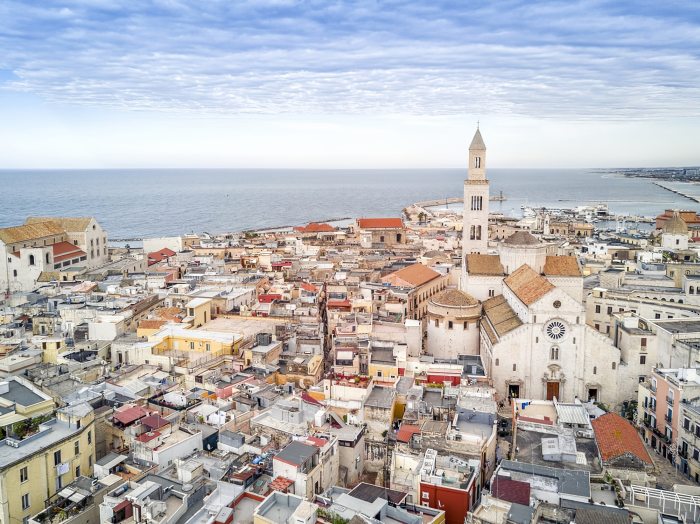
Bari, the vibrant capital of Puglia, boasts a rich and storied past that spans centuries. Its strategic location on the Adriatic coast has made it a crossroads of cultures, leaving an indelible mark on its history.
Ancient Origins
Bari’s origins can be traced back to the ancient city of Barium, founded by the Romans in the 3rd century BCE. The city became an important port and a center of commerce, attracting traders from across the Mediterranean.
Byzantine Influence
In the 6th century CE, Bari fell under Byzantine rule. The Byzantines left a lasting legacy on the city, constructing the imposing Basilica of San Nicola, which houses the relics of Saint Nicholas. Bari also became a major center of Greek Orthodox Christianity.
Norman Conquest
In the 11th century, Bari was conquered by the Normans, who made it the capital of the County of Apulia. The Normans brought with them a new wave of architectural influences, including the construction of the Castello Normanno-Svevo, a formidable fortress that still stands today.
Hohenstaufen and Angevin Rule
After the Norman period, Bari passed into the hands of the Hohenstaufen and then the Angevin dynasties. During this time, the city continued to flourish as a commercial and cultural center. It became a major center of silk production and a hub for trade with the East.
Bari, with its beautiful beaches, is the perfect place to enjoy a relaxing beach holiday. If you’re planning a trip to Bari, be sure to check out our beach holiday packing list to make sure you have everything you need for a fun and comfortable vacation.
From sunscreen and sunglasses to beach towels and swimwear, we’ve got you covered. And don’t forget to pack a good book to enjoy while you’re soaking up the sun on the beach in Bari.
Renaissance and Baroque Periods, Bari
The Renaissance and Baroque periods saw a renewed interest in classical architecture and art in Bari. The city’s churches and palaces were adorned with elaborate decorations and frescoes. The Teatro Petruzzelli, one of Italy’s most famous opera houses, was built during this time.
Modern Bari
In the 19th century, Bari underwent a period of industrialization and modernization. The city became a major center for shipbuilding and trade. In the 20th century, Bari played a significant role in the Italian Resistance during World War II. Today, Bari is a thriving modern city that retains its rich historical heritage.
Bari’s Culture
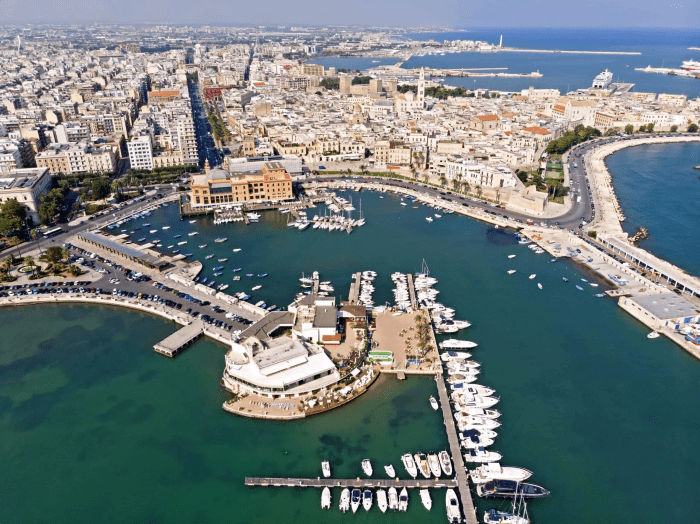
Bari boasts a unique cultural identity shaped by its rich history and geographic location. The city’s traditions, customs, and festivals reflect a vibrant blend of influences from Italy, Greece, and the Mediterranean region.
Art and Architecture
Bari has a long and distinguished history in art and architecture. The city is home to numerous churches, cathedrals, and palaces that showcase a variety of architectural styles, including Romanesque, Gothic, and Baroque. The Basilica of San Nicola, a UNESCO World Heritage Site, is a masterpiece of Romanesque architecture and houses the relics of Saint Nicholas.
Bari is also known for its contemporary art scene. The city has several art galleries and museums, including the Pinacoteca Provinciale and the Museo Civico di Bari, which feature works by local and international artists.
Music and Literature
Bari has a thriving music scene, with a wide range of genres represented. The city is home to several opera houses, concert halls, and music festivals. The Teatro Petruzzelli, one of the largest opera houses in Italy, hosts performances by world-renowned opera singers and orchestras.
Bari has also produced a number of notable writers, including the poet Niccolò Tommaseo and the novelist Francesco De Sanctis. The city is home to several literary festivals and events, including the Bari International Book Fair.
Bari’s Architecture
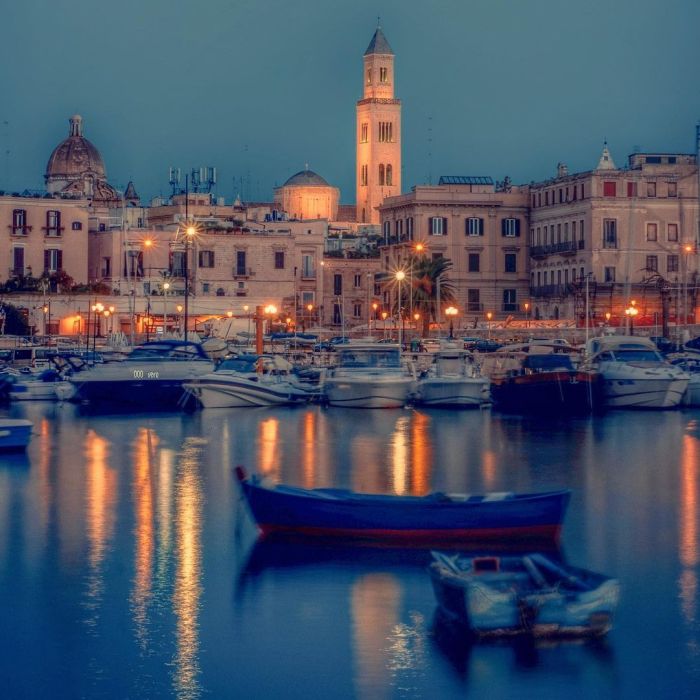
Bari’s architectural heritage reflects the city’s rich history and cultural influences. The city boasts a diverse range of architectural styles, from ancient Roman ruins to medieval churches and Renaissance palaces.
Architectural Styles
The most prominent architectural styles found in Bari include:
- Romanesque: Characterized by round arches, thick walls, and small windows.
- Gothic: Featuring pointed arches, ribbed vaults, and elaborate ornamentation.
- Renaissance: Emphasizing symmetry, classical proportions, and decorative elements.
- Baroque: Known for its grandeur, curved lines, and elaborate ornamentation.
- Neoclassical: Inspired by ancient Greek and Roman architecture, with its emphasis on clean lines and simple forms.
Notable Buildings
Some of the most notable buildings in Bari include:
| Building | Architectural Style | Significance |
|---|---|---|
| Basilica di San Nicola | Romanesque | One of the most important pilgrimage sites in Italy, housing the relics of Saint Nicholas. |
| Cathedral of Bari | Romanesque and Gothic | The city’s main cathedral, with a distinctive blend of architectural styles. |
| Castello Normanno-Svevo | Norman and Swabian | A medieval fortress that served as the residence of the Norman and Swabian kings. |
| Teatro Petruzzelli | Neoclassical | One of the largest opera houses in Italy, known for its impressive facade and grand interior. |
| Palazzo della Provincia | Neoclassical | The seat of the provincial government, with its elegant columns and grand staircase. |
Bari’s Economy
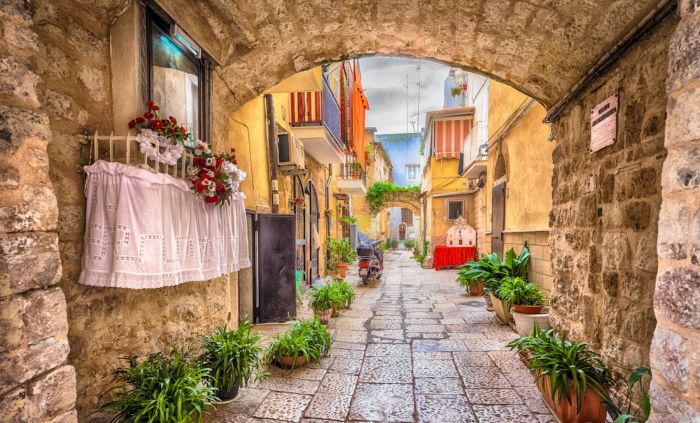
Bari’s economy is primarily driven by tourism, agriculture, and industry. The city is a popular destination for both domestic and international tourists, drawn by its historical landmarks, beaches, and cuisine.
Agriculture
Agriculture plays a significant role in Bari’s economy. The surrounding region is known for its production of olives, almonds, grapes, and citrus fruits. Bari is also a major center for the production of olive oil.
Industry
Bari is home to a number of industries, including food processing, textiles, and chemicals. The city is also a major shipbuilding center.
Bari is an ancient city in southern Italy, with a rich history and culture. The city is home to many historical sites, including the Basilica of San Nicola, which is one of the most important pilgrimage sites in Italy. Bari is also a popular tourist destination, with its beautiful beaches, charming old town, and delicious cuisine.
In the region surrounding Bari, you can explore the fascinating culture of the bedouin , who have inhabited the area for centuries. Their nomadic lifestyle and traditional customs offer a glimpse into a unique and ancient way of life. Bari serves as a gateway to this captivating region, where the past and present intertwine.
Trade
Bari is a major regional and international trade center. The city’s port is one of the largest in Italy, and it handles a significant volume of goods from around the world.
Economic Performance
Bari’s economy has performed well in recent years. The city’s GDP has grown steadily, and unemployment has remained low. Bari is also a major center for research and development, and the city is home to a number of universities and research institutions.
Bari’s Geography and Climate
Bari is strategically positioned on the southeastern coast of Italy, along the Adriatic Sea. This coastal location has profoundly influenced the city’s history, economy, and culture. The city’s proximity to the sea has facilitated trade and cultural exchange, making it a significant port city and a gateway to southeastern Europe.
Geographical Features
- Bari Vecchia (Old Bari): The historic center of Bari, located on a small peninsula jutting into the Adriatic Sea. It is surrounded by ancient city walls and features narrow streets, charming piazzas, and historic buildings.
- San Nicola Basilica: A renowned pilgrimage site and one of the most important religious landmarks in Bari. It houses the relics of Saint Nicholas, the patron saint of Bari.
- Castello Normanno-Svevo (Norman-Swabian Castle): A 12th-century castle built by the Normans and later expanded by the Swabians. It served as a defensive fortification and a royal residence.
- Lungomare Nazario Sauro: A scenic seaside promenade that stretches along the Adriatic coast, offering stunning views of the sea and the city skyline.
- Pinacoteca Provinciale di Bari (Provincial Art Gallery of Bari): A museum showcasing a collection of paintings and sculptures from the 13th to the 20th centuries.
Climate
Bari enjoys a Mediterranean climate, characterized by warm, dry summers and mild, wet winters. The city experiences an average temperature of 16°C (61°F) throughout the year, with highs reaching up to 30°C (86°F) in the summer months and lows dropping to around 5°C (41°F) in the winter months. The city receives an average of 600 mm (24 inches) of rainfall per year, primarily during the winter and spring months.
Bari’s Transportation
Bari boasts a well-developed transportation infrastructure, connecting it seamlessly to the rest of Italy and beyond.
The city is served by Bari Karol Wojtyla Airport (BRI), offering both domestic and international flights. The airport is conveniently located just 8 kilometers from the city center, accessible via a direct train line or public buses.
Train Station
Bari’s central train station, Bari Centrale, is a major transportation hub in southern Italy. It connects Bari to numerous cities across the country, including Rome, Milan, Naples, and Lecce. The station offers a range of train services, from high-speed Frecciarossa trains to regional trains.
Public Transportation
Bari’s public transportation system is extensive and efficient. The city is served by a network of buses, trams, and a metro line. The public transportation system is affordable and reliable, making it a convenient option for getting around the city.
Bari is a vibrant city in southern Italy known for its historic architecture and bustling nightlife. However, if you’re looking for a more relaxed beach getaway, consider exploring the nearby 30a florida. This stretch of pristine coastline offers sugar-white sands, turquoise waters, and charming beach towns.
While in 30a florida, be sure to visit the Grayton Beach State Park, known for its coastal dune lakes and abundant wildlife. After soaking up the sun and surf, return to Bari for a delightful evening of authentic Italian cuisine and lively street entertainment.
Accessibility and Connectivity
Bari’s transportation infrastructure makes it easily accessible from other regions of Italy and Europe. The city is well-connected by air, rail, and road, making it a convenient destination for both tourists and business travelers.
Transportation Costs and Options
Transportation costs in Bari are comparable to other major cities in Italy. A single bus ticket costs around €1.50, while a monthly pass for unlimited travel on all public transportation costs around €30. Taxis are also readily available and offer a convenient way to get around the city.
Bari’s Cuisine

Bari’s cuisine is a reflection of the city’s rich history and culture. The flavors are bold and robust, with a focus on fresh, local ingredients. Traditional cooking methods are still widely used, such as wood-fired ovens and handmade pasta.
Popular Dishes
Some of the most popular dishes in Bari include:
- Orecchiette con cime di rapa: A pasta dish made with small ear-shaped pasta (orecchiette) and sautéed turnip greens (cime di rapa).
- Focaccia barese: A thick, fluffy flatbread topped with tomatoes, olives, and oregano.
- Panzerotti: A fried or baked turnover filled with various ingredients, such as mozzarella cheese, tomato sauce, and meat.
- Sgagliozze: A type of fried polenta that is often served with seafood or vegetables.
- Cartellate: A sweet pastry made with thin strips of dough that are rolled up and fried.
Bari’s Tourism

Bari, the capital of Puglia, is a vibrant and welcoming city that attracts tourists from all over the world. Its rich history, stunning architecture, and delicious cuisine make it an ideal destination for those looking to experience the true essence of southern Italy.
Bari’s appeal as a tourist destination lies in its unique blend of ancient and modern. The city’s historic center, Bari Vecchia, is a labyrinth of narrow streets and whitewashed houses that date back to the Middle Ages. Visitors can explore the city’s ancient walls, visit the Basilica of San Nicola, and admire the stunning Norman-style architecture of the Cathedral of San Sabino.
In addition to its historical landmarks, Bari also offers a variety of cultural attractions. The city is home to several museums, including the Museo Archeologico di Bari, which houses a collection of artifacts from the city’s long history. Visitors can also enjoy the city’s vibrant theater and music scene, with performances taking place throughout the year.
Bari is also known for its natural beauty. The city is located on the Adriatic coast, and its beaches are a popular destination for swimming, sunbathing, and water sports. Visitors can also take a boat trip to the nearby Tremiti Islands, which are a haven for nature lovers.
Recommended Tourist Itineraries
There are many different ways to experience Bari’s unique charms. Here are a few suggested itineraries:
* One-day itinerary: Start your day by exploring Bari Vecchia, visiting the Basilica of San Nicola and the Cathedral of San Sabino. In the afternoon, relax on one of the city’s beaches or take a boat trip to the Tremiti Islands. Finish your day with a delicious dinner at one of Bari’s many traditional restaurants.
* Two-day itinerary: On your second day in Bari, visit the Museo Archeologico di Bari to learn about the city’s history. In the afternoon, take a walk through the city’s modern center, admiring the architecture and shopping for souvenirs. In the evening, enjoy a performance at one of Bari’s theaters.
* Three-day itinerary: On your third day in Bari, take a day trip to the nearby town of Alberobello, which is famous for its unique trulli houses. In the evening, return to Bari and enjoy a farewell dinner at one of the city’s many rooftop restaurants.
Bari’s Education
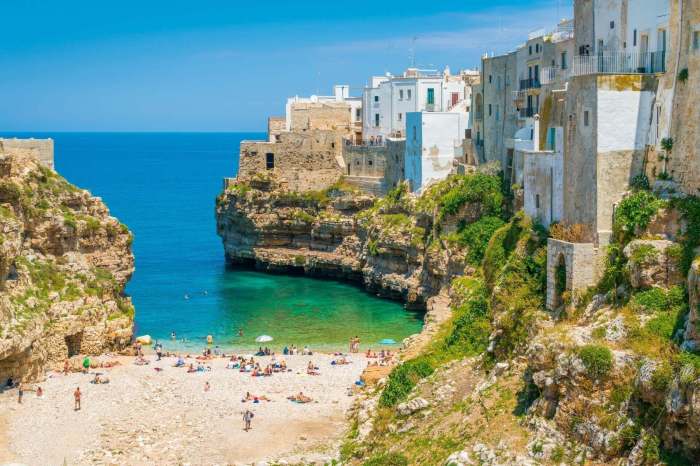
Bari is a vibrant city that places great importance on education and research. It is home to a wide range of educational institutions, including universities, schools, and libraries, offering a diverse range of educational opportunities.
The city’s commitment to education is reflected in its investment in higher education. The University of Bari, founded in 1925, is one of the largest and most prestigious universities in southern Italy. It offers a comprehensive range of undergraduate and graduate programs across various disciplines, including medicine, law, engineering, and the humanities.
In addition to the University of Bari, the city is home to several other higher education institutions, such as the Polytechnic University of Bari, the University of Salento, and the University of Foggia. These institutions offer specialized programs in fields such as engineering, architecture, and agriculture.
Bari also has a strong network of primary and secondary schools. The city’s schools provide a high-quality education, preparing students for further studies or entry into the workforce. Many of the schools offer specialized programs, such as language immersion programs and vocational training.
The city’s commitment to education extends beyond formal institutions. Bari has a number of libraries and cultural centers that offer educational programs and resources. The Biblioteca Nazionale di Bari, the largest library in southern Italy, houses a vast collection of books, manuscripts, and other materials. The city also has several museums and art galleries that offer educational exhibitions and programs.
Bari’s Healthcare

Bari’s healthcare system is comprehensive and well-developed, providing a wide range of medical services to its residents. The city is home to several hospitals, clinics, and healthcare professionals, ensuring that patients have access to quality healthcare services.
Hospitals and Clinics
Bari boasts a number of renowned hospitals, including the Policlinico di Bari, the largest hospital in the region. Other major hospitals include the Ospedale San Paolo, the Ospedale Di Venere, and the Ospedale San Giovanni Bosco. These hospitals offer a full range of medical services, from primary care to specialized treatments.
In addition to hospitals, Bari has numerous clinics and specialized medical centers. These clinics provide a variety of services, including general medicine, pediatrics, gynecology, and orthopedics. Many clinics also offer specialized services, such as cardiology, neurology, and oncology.
Healthcare Professionals
Bari is home to a large number of highly skilled healthcare professionals, including doctors, nurses, and other medical staff. These professionals are dedicated to providing quality healthcare services to the city’s residents. Many healthcare professionals in Bari have received their training at the University of Bari’s medical school, which is known for its excellence in medical education.
The quality of healthcare services in Bari is generally considered to be high. Hospitals and clinics in the city are well-equipped and staffed with experienced medical professionals. Patients have access to a wide range of medical services, and the quality of care is comparable to that of other major cities in Italy.
Closure
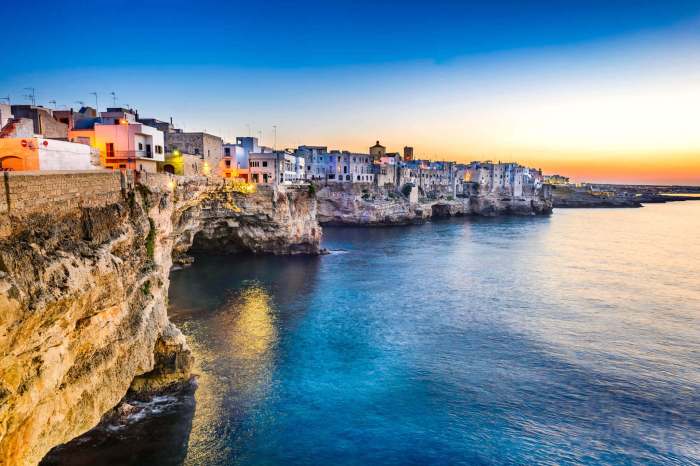
As we bid farewell to the enchanting city of Bari, we leave with a heart filled with memories and a profound appreciation for its timeless allure. From the depths of its history to the vibrancy of its present, Bari has woven a spell that will forever linger in our minds. Whether you seek historical wonders, cultural immersion, or simply the warmth of southern Italian hospitality, Bari awaits with open arms, promising an unforgettable experience that will ignite your senses and leave you yearning for more.
Key Questions Answered: Bari
What is Bari famous for?
Bari is renowned for its stunning architecture, particularly the Basilica di San Nicola, which houses the relics of Saint Nicholas. The city is also famous for its vibrant street life, delicious cuisine, and its role as a gateway to the picturesque region of Puglia.
What is the best time to visit Bari?
The best time to visit Bari is during the shoulder seasons (April-May and September-October) when the weather is pleasant and there are fewer crowds. However, Bari is a year-round destination with something to offer in every season.
What are the must-see attractions in Bari?
Must-see attractions in Bari include the Basilica di San Nicola, the Castello Normanno-Svevo, the Petruzzelli Theatre, and the Lungomare Nazario Sauro. The city also offers a wealth of hidden gems and off-the-beaten-path experiences.